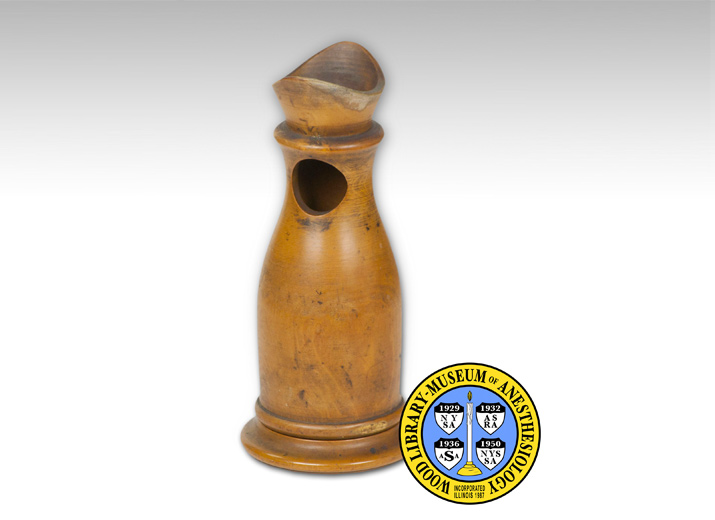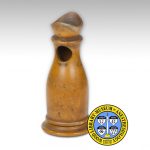Hedley Inhaler
Numerous inhalers were designed in the year following Morton’s demonstration. Dr. Hedley registered (patented) his inhaler in Birmingham, England on April 7, 1847. This inhaler would have contained a sponge or cloth soaked with ether, and the patient would have placed his mouth against the curved top to inhale the anesthetic vapor.
Although wood proved to be a poor choice of material for anesthetic inhalers, the Hedley inhaler is good example of the numerous attempts made to overcome problems with the early glass inhalers. This kind of inhaler may have been used by physicians before better-functioning metal inhalers where readily available.
Catalog Record: Hedley Inhaler
Access Key: aikb
Accession No.: 2007-03-20-1 A
Title: [Hedley ether inhaler.]
Author: Hedley, Dr.
Title variation: Alt Title
Title: Hedley’s wooden inhaler.
Publisher: [S.l. : s.n., ca. 1847.]
Physical Description: 1 inhaler : wood ; 19.5 x 9 dia. cm.
Subject: Inhalers, Anesthesia – Great Britain.
Subject: Ether, Ethyl.
Subject: Chloroform.
Subject: Nonrebreathing Valves.
Subject: Anesthesia, Inhalation.
Note Type: General
Notes: Title from the Wood Library Museum’s name for the apparatus.
Note Type: General
Notes: The Wellcome Collection in London holds a similar Hedley Inhaler (with
expiratory valve in place) and can be viewed at https://www.sciencemuseum.org.
uk (accessed 7/27/2010).
Note Type: Physical Description
Notes: A cylindrical wooden inhaler with a pleasantly curved shape, on a round base,
or coaster, topped by a mouth piece; From the patient’s point of reference,
near the proximal end, below the mouth piece, on one side of the inhaler is a
circular opening; This opening once held an expiratory valve; The expiratory
valve for this example of the inhaler is missing; The wood is cracked on the
side opposite the opening for the valve; At the distal end, the base can be
twisted off for access to the sponge compartment; An inspiratory valve is
located above the sponge compartment, in the body of the inhaler; A small,
round, puckered, paper label, with manufacturer’s markings, is affixed to the
base of the inhaler: “BY ACT [new line] OF [new line] PARLIAMENT, [new line]
6 & 7 Victoria, [new line] Cap. 65, [new line] REGISTERED [new line] 7th
April, 1847.”
Note Type: Reproduction
Notes: Photographed by Mr. William Lyle, July 14, 2010.
Note Type: Historical
Notes: Not much is known of the inhaler’s designer, Dr. Hedley, except that he is
likely to have lived in or near Bedford, England. This inhaler could have
been used to deliver ether or chloroform. This kind of inhaler may have been
used by physicians before better-functioning metal inhalers where designed
and readily available.





